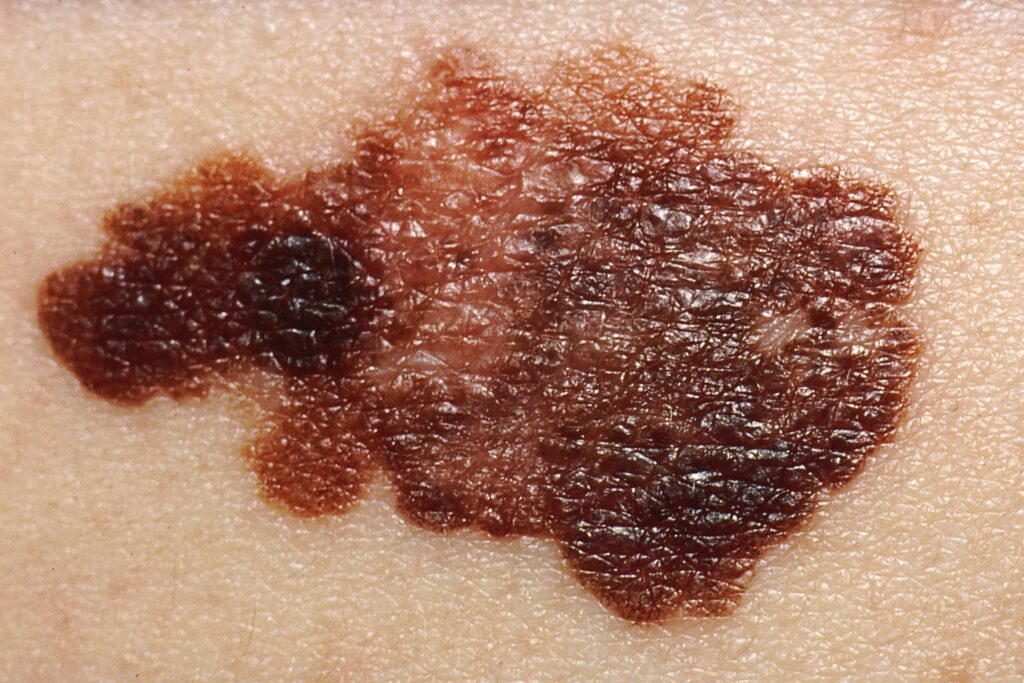
It often starts with something small—a dark spot on the skin that looks a little off. A dermatologist takes a closer look, runs a biopsy, and soon after, the diagnosis arrives: melanoma. If the cancer is advanced, treatment may include immune checkpoint inhibitors—drugs that help the body’s own immune system recognize and attack the cancer.
For some patients with aggressive melanoma—one of the deadliest forms of skin cancer—immune checkpoint inhibitors offer the potential for long-term remission. But while some people respond well to Immune Checkpoint Blockade (ICB) therapies, others are resistant to the treatment.
Tomas Kirchhoff, PhD, associate professor in the department of population health at NYU Grossman School of Medicine and a member of the Perlmutter Cancer Center tells GEN, “The fact that [ICB therapy] doesn’t work for everyone, [it was suspected that] this would likely be somehow genetically predisposed.”
Now, a new study from Nature Medicine titled, “Inherited mitochondrial genetics predicts clinical efficacy of immune checkpoint inhibition therapies in melanoma,” may shed light on the role of genetics in this process—and the answer may lie in an unexpected place: the mitochondria.
To better understand why some patients lack the immune environment needed for ICB’s to work, the team compared genetic traits in circulating immune cells from patients who respond to checkpoint inhibitors versus those who don’t. They hypothesized that mitochondrial DNA might influence a patient’s metabolic and immune profile, affecting their response to checkpoint inhibitor therapy in melanoma.
The landmark Phase III trial, CheckMate-067, explored potential links between mitochondrial genetics, immunity, and treatment outcomes by analyzing blood samples across 19 countries. Checkpoint inhibitors, like nivolumab and ipilimumab used in the CheckMate-067 trial, are immunotherapy drugs that block proteins like PD-1 or CTLA-4, which normally act as brakes on T cells. By disrupting these “off” signals, the drugs help the immune system recognize and attack cancer cells. According to the study, patients with a specific type of genetic mutation in mitochondrial DNA, called MT haplogroup T (HG-T), were 3.46 times less likely to respond to checkpoint therapy than those without HG-T.
Ultra-low-coverage whole-genome sequencing (lcWGS) identified mitochondrial genetic variants. Integrating lcWGS into a broader framework allowed the researchers to explore how mitochondrial genetics influence immune checkpoint inhibitor response, remarked Kirchhoff.
“We never thought that mitochondrial genetics, while important in many rare diseases, would play such a noticeable role,” said Kirchhoff. Mitochondria, once thought to be simple energy producers, are now recognized as dynamic organelles with complex roles, including communication between tumor and immune cells.
Jesse Salk, MD, PhD, a clinical oncologist at the Fred Hutchinson Cancer Center and VA Healthcare System in Seattle who was not involved in the study, provided his views of the study and potential future studies: “It would be interesting to do studies where the immune system had a particular haplotype, but the cancer itself had a different one. It could be looked at in people who have undergone bone marrow transplants for hematologic malignancies. Their hematopoietic cells, T cells, neutrophils, and whatnot have one genotype which will have a particular mitochondrial variety, but the tumors themselves will be of the recipient’s genotype.”
Salk continued that while the mitochondrial biomarker shows potential, the study’s significance lies in the insight to molecular pathways that could potentially be amazing new drug targets for new immunotherapies or combination therapies to help existing checkpoint inhibitors work better.
While the focus of this study was on host immune cells, the researchers highlight that the same genetic factors might also affect tumor metabolism—an area ripe for future exploration and therapeutic targeting.
Kirchhoff also noted potential avenues for cancers that are unresponsive to immune checkpoint inhibition therapies. “It’s possible. We don’t even understand very well what it means in the context of treatments that are responsive to the patients. How to make the particular cancer phenotypes responsive is a whole different field…we strongly suspect, however, that if we capture potential further biological information in this genetic repertoire that we have identified in mitochondria, we’ll be able to understand the functional effect of this genetic information, which may be potentially manipulable.”
There is also a possibility of a combination with other therapies, to extend beyond melanoma. Kirchhoff shared, “…[the researchers] are having a large test currently underway that will collect information from all the other tumor types that are being treated with these therapies to see if this particular observation has broad clinical applicability across cancers.”
Another finding uncovered by the study links a specific mitochondrial haplogroup to reduced immune cell levels in the blood. More specifically, treatment-resistant HG-T patients had more underdeveloped T cells than nonresistant patients without HG-T. Although the haplogroup does not predict cancer risk or response to infections, it could impact how patients respond to checkpoint inhibitor therapy—a finding that Kirchhoff’s group is actively exploring. “We have a parallel treatment option for these patients that works through a different drug that is less sensitive to the effect of these mitochondrial haplogroups,” he says. The team hopes to release a publication in the near future.
While further experiments are needed to determine the precise role played by mitochondrial genetics, ROS, metabolism and anti-tumor T-cell immune cancer therapy, the research team’s long-term goals include potentially developing a clinical test that can identify patients unlikely to benefit from checkpoint inhibitor therapy, helping doctors avoid exposing them to potentially toxic and ineffective treatments.
“It’s one of the most beautiful examples of the crosstalk between the two worlds that are joining forces here to really deliver this clinically useful information that can help patients down the line,” Kirchhoff shared. With alternative therapies emerging, this test could guide personalized treatment choices. Eventually, understanding the biological mechanisms behind reduced immune cell levels—linked to mitochondrial genetics—may allow for pretreatment strategies to reverse this immune deficiency and enable more patients to benefit from existing or new immunotherapies.



